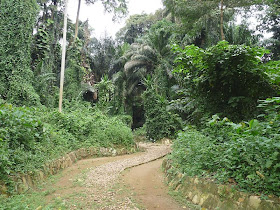When I visited Uganda a couple of years ago I absolutely loved the country. My introduction to it was Entebbe Botanic Gardens, where I walked on my very first morning there. On that walk I discovered an interesting truth about poor damaged Uganda, where some of the most appalling things were done within the memory of any citizen over the age of about 40. This was that almost universally people will say "hello, how are you?" - and mean it, waiting for an answer! Entebbe is a town of less than 100,000 people (but growing) almost on the equator on the shores of mighty Lake Victoria, source of the Nile, and only 30 kilometres south of the sprawling capital, Kampala.
The gardens were founded around the turn of the 20th Century and cover some 35 hectares. Parts of them look a bit shabby now, but like the rest of the country they suffered badly in the Amin years and those that followed, and like the rest of the country they are being helped to recover. The plantings include specimens from all over the world, plus some rainforest remnants...
 |
| Rainforest track. |
...and of course the lake shores.
 |
| Fishermen on Lake Victoria from the gardens (above). Marabous and African Open-billed Storks on the shore (below). |
For an entrance fee (at the time) of the equivalent of A50 cents (plus A$1.50 for the camera!) it's great value and an excellent introduction to the birds. For a few dollars more you can have a guide for an hour or so; they may or may not know the birds, though my new mate Alex did. And for anyone new to east or central Africa, the birds can be an eye-opener. Here are some examples.
 |
| Scarlet-chested Sunbird (Chalcomitra senegalensis). This is a widespread and exquisite sunbird. |
 |
| Palm-nut Vulture (Gypohierax angolensis) - it really does live substantially on oily palm-nuts! |
 |
| Splendid Starling (Lamprotornis splendidus). |
 |
| Woodland Kingfisher (Halcyon senegalensis); this delightful bird (we can't see its bright blue wings here) was everywhere the day I was there. |
 |
| Black-and-White-Casqued Hornbill (Ceratogymna subcylindrica). Probably the star of the day for me. |
 |
| Pied Kingfisher (Ceryle rudis). As in much of Africa - and east into Asia - this is one of the commonest birds along the lake shore. |
 |
| Egyptian Goose (Alopochen aegyptiacus) family on the lake. |
 |
| Hamerkop (Scopus umbretta), a truly fascinating bird, not least because it is the sole member of its family, and it is unclear even what Order it belongs to. |
Nor are birds the only residents of course. Any place with resident monkeys is fine by me!
 |
| Vervet Monkey (Chlorocebus pygerythrus). |
I'm also a big fan of squirrels.
 |
| Striped Ground Squirrel (Xerus erythropus). |
 |
| Unidentified dragonfly - sorry! |
I hope you find your way there some day; I'm sure you'll love it as I did.
And now I've started, I suspect that more botanic gardens will feature here from time to time.
BACK THURSDAY


Jizz tells me it's Libellulidae, but I wouldn't attempt to ID any Libellulid from a single photo of its rear end, much less a Ugandan one.
ReplyDeleteIt is interesting to compare this very interesting place with the Dar es Salaam Botanic Gardens.
ReplyDeleteThe DSM place is small (about the size of Glebe Park in Canberra) and with few trees and next to no birds. I saw no evidence of any guides. When we lived there (2001-03, it was also not a place where you would take your binoculars or camera if you wished to keep them!
While thinking of DSM the phrase "Someone is looking for you" implied, in the idiom of that city, that you would not be happy if they found you. This would certainly be the case if it was an Olive Baboon looking for you!
Martin